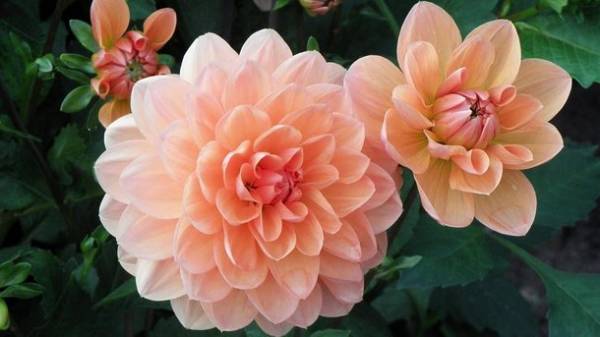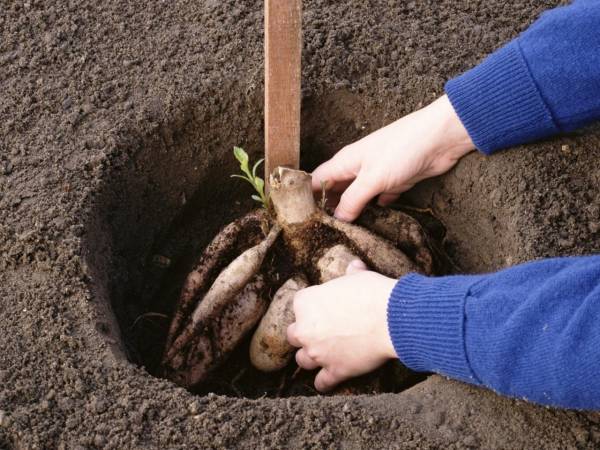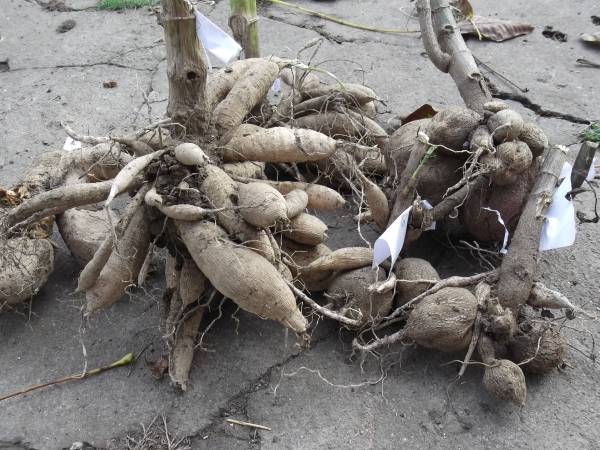
Dahlias are favorites among postnecrotic flower plants. The great popularity they have gained for their spectacular flowers that adorn the land to the very cold weather, when many other perennials have long withered. Besides, there are so many varieties that you can pick up for flower beds color, size, or appearance for every taste! What you need to know about the secrets of growing darlings of the fall garden?
THE PIT FOR PLANTING
The tubers are prepared in April. Out of cool storage, remove dead parts, and place slices sprinkled with ashes. Big — share. Then they are planted in a container for germination, and when to germinate — along with a clod of earth in open ground. You can do without a pre-germination, planting tubers directly into the soil so that the root collar was buried at 2-3 cm
Now you can buy already prepared tubers: selecting them, make sure they are tight and elastic, not dry and have a little rest from the escape. Dahlias are planted when the soil is well warmed up — until may — early June. Be sure to carefully choose the places it should be protected from wind and sun: the plant is pleasing to the lush flowers, the planting site should be illuminated for at least 6 hours a day. Before planting, the tubers can hold half an hour in a weak solution of potassium permanganate for prevention of diseases and pests.
“At the bottom of the pit put a bit of manure, then 20 g of superphosphate and complex fertilizers, a handful of lime and ash, says Peter Rakovec. — All fertilizer is thoroughly mixed with the earth. The size of the planting holes approximately 40 × 40 cm, depth 30 cm Plant the tubers at a distance of 70-90 cm from each other, and low-growing varieties — 30-60 cm.”

The planting hole. Size: 40×40 cm, depth 30 cm
VARIETAL DIVERSITY
“In the world it is known more than 15 thousand varieties of dahlias. They differ in size, shape and color of inflorescences, says Odessa dendrologist, a specialist company “Your garden” Peter Rakovec. — On this basis they are grouped into 12 types: 1 — single, 2 — anemone, 3 — collar, 4 — peony, 5 — straight cactus, 6 — cactus with curved petals, 7 spherical, 8 — pompon, 9 — decorative, 10 — nampanya, 11 — mixed, 12 — polyactive.
World leaders in breeding dahlias are the USA, France, Netherlands, UK and Japan. Quite a lot of varieties known throughout the world, brought our compatriot Nikolay Petrovich Yaschenko. Working in Kyiv Central Botanical garden, he brought forth the varieties of “Eternal flame”, “Heart of Danko”, “Babi Yar”, “Crane” and others.”
PROPAGATION OF PLANTS
Most often dahlias are propagated by division, which is used to rejuvenate plants that flowers had been getting shallower. The procedure produced in the autumn, before placing tubers in storage or in the spring before planting.
“In the autumn, with the onset of sustained cold weather, the stems of the plants must be cut rhizome digging, well washed and dried, — shares his experience gardener from Kiev region Svetlana School. — The division of the produce with your hands or with a knife. Divide the rhizome so that each delenki was 1 tuber with 1-2 buds at the root collar.
Dahlias can be propagated and cuttings: in this case, the plants will be more disease resistant and the flowers larger. To do this, in March the tubers should be laid in a box with soil so that the root collar of the tuber remains. The substrate should regularly moisturize and keep in a warm room. When you see the sprouts, the box put in a bright place. When the shoots reach 7-12 cm, they are cut and roots in boxes with moist coarse sand (it must be watered regularly). You can cover the box with foil, periodically airing. After 3-4 weeks the cuttings will take root, and they can be planted in the ground. And tubers on which they are formed, are also suitable for the further landing”.
You can grow dahlias from seed, although this method is more troublesome. Seeds collected in the fall, spring sown in moist substrate, covered with foil and keep in a bright room with a temperature of about 25 °C, regularly slightly moistening the soil. When you see 3-4 leaves, seedlings, and later planted in the open ground.
PESTS AND DISEASES
Dahlias are most often exposed to diseases such as black leg, Sclerotinia, mosaic virus, Fusarium. Blackleg mainly affects young plants. She gets on the tubers from the soil and is growing rapidly: the young leaves and stem die off. This disease is not treatable, so the methods of dealing with it radically: the plant is dug up and burned and the soil in its place is treated with 5% solution of potassium permanganate.
The Sclerotinia often infects plants with a lack of sunlight, or weak, damaged copies. The stems appear gray spots, the stem softens and whitens. If you have noticed similar lesions will remove the diseased stem, and the cut is sprinkle charcoal.
Mosaic virus infects the leaves. They have yellow spots, the growth of a Dahlia is terminated, and the flowers are not blooming. Affected plants should be uprooted and destroyed.
Fusarium infects the tubers during winter storage: they are covered with brown spots and gradually perish. Upon detection of the slightest signs of the disease, the tubers should be treated with potassium permanganate or coal, and if this does not help — to destroy. Among the main enemies of the pests of dahlias are aphids, various beetles, their larvae and caterpillars, thrips, snails and spider mites. Upon detection of the insects, treat the plants “Antioxidant.”, “Vozalona”, “Malathion” (in a concentration of 0.2—0.3%), tincture of yarrow (8%), onion peel.
STORAGE: SAND, SAWDUST, AND PARAFFIN
Dig the tubers in mid — late October after the first frost, which they harden. “The stems are cut to stumps of 10-15 cm, and the tubers treated with fungicide, for example, Phytosporin or potassium permanganate (aged in the solution for about 30 minutes) — says Peter Rakovec. — Then the tubers should be dried, and when dry, put tightly in plastic containers and cover with wet sand or sawdust”.
Store the containers in a damp cellar at a temperature of 1-10°C. it is Periodically necessary to check, did dahlias to rot in the spring not to get a nasty “surprise”.
There are other ways of storage. The tubers are dipped in melted paraffin and kept at the temperature 12— 14 °C. you can Also put them in a box with peat (stored at 3-5 °C) or in a cardboard box, shifting paper.

Good tubers. Dense, elastic, not dry, with a small remainder of last year’s escape







